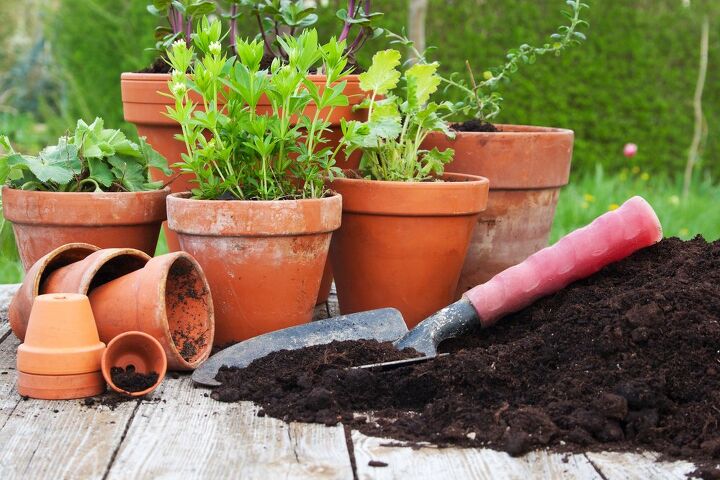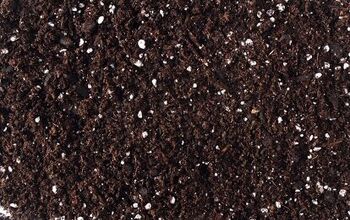Can You Use Garden Soil In Pots?

Planting a garden adds beauty to your home’s exterior and is also a great stress reliever. But if your plants struggle to grow, it can become frustrating. Gardening takes knowledge for flowers, plants, and veggies to flourish, like choosing the proper soil and planting space. If you decide to use planters, you might wonder if you can use garden soil in pots?
Using some garden soil as a base inside a pot is okay, but you should primarily use potting mix. Potting mix is the best soil for pots because it has the ideal balance of nutrients and moisture retention. Garden soil is too heavy, causing compaction that chokes plant roots. Avoid using any soil in pots if you can.
What Happens If I Use Garden Soil In Pots?
If you use garden soil in pots, it could potentially kill your plants for several reasons. You may have noticed that a bag of potting mix feels lighter than a comparable-sized bag of garden soil, like Miracle-Gro.
This weight difference is no accident. The soil is heavier than the potting mix, posing some issues if you use garden soil in pots. The same holds true for garden soil you scoop direct from the ground.
First, it makes your potted plant a lot more challenging to move around due to the extra weight. Plus, all that excess weight will contribute to compacting the soil when you water your plants. If the dirt gets too compacted, it doesn’t leave room for proper aeration.
Instead, the water won’t drain correctly, meaning overly wet soil with no air for your plants. Another issue with using garden soil in pots is your plants and flowers won’t get suitable nutrients. Potting mix includes all the nutrients your plant needs that they would typically gain from the ground.
Can You Use Garden Soil For Indoor Pots?
It’s best to avoid using garden soil indoors. It’s natural soil, which can introduce pests, fungus, and other issues inside your home.
Potting mix is the optimal choice for planting in pots, especially indoor ones. If you don’t want your house smelling like potting soil, check out this article.
Can You Use Top Soil In Pots?
You should avoid using any soil in pots, just like you should avoid using potting mix to fill a hole in your yard. Top soil also is too heavy, causing compaction, drowning your plants, and lacking nutrients.
Can You Mix Garden Soil With Potting Soil?
If you start your planting project and realize you’re running low on potting mix, using some garden soil is okay. You can mix the two, but this combo works better in raised beds. You should avoid mixing garden soil and potting mix in containers.
How Can You Amend Garden Soil For Pots?
If you don’t have potting mix, you can amend garden soil to use in pots by adding things for moisture retention and aeration. You will also need to add fertilizer.
The garden soil won’t have the necessary nutrients your flowers, plants, and veggies would otherwise get from the ground. Potting mix already includes all of these essential goodies.
Use a formula of one part garden soil, one part moisture retention ingredient, and one part aeration and drainage. More on these ingredients in a moment. Then you’ll also need to include the proper amount of fertilizer.
The amount depends on the size pot and the type of fertilizer you choose. Read the labeling carefully to use the correct amount of plant food.
Ingredients For Amending Garden Soil For Pots
Go with equal parts for your ingredients (not including the fertilizer). You can use bagged garden soil like Miracle-Gro or Sta-Green or scoop garden soil from the ground.
Providing Aeration and Drainage In Your Potting Mix
For aeration and drainage, popular options are perlite, sterilized rice hulls, or horticultural sand. Perlite looks like tiny styrofoam balls, but they’re actually volcanic glass heated at high temperatures. It’s a common addition to potting mixes, helping plants hold onto just the right amount of water.
Horticultural sand usually is crushed granite, sandstone, or quartz, featuring a very gritty texture. The coarse texture allows for better drainage. Rice hulls are an alternative to perlite that typically cost less but work as effectively.
Adding Moisture Retention
For moisture retention, the most common options are peat moss or vermiculite. Peat moss isn’t the most eco-friendly option, but you’ll find it in most potting mixes.
Vermiculite is a natural mineral compressed into small pellets. You’ll find it in a bunch of seed-starting mixes because it protects seedlings from fungus. It absorbs water, making it a no-brainer for moisture retention.
Other options for moisture retention in your DIY potting mix are coconut coir (coconut fiber), worm castings (earthworm waste), and compost. You can also make leaf mold or use locally-sourced wood byproducts free from chemicals, like sawdust or composted bark.
Another option is PittMoss, which consists of recycled paper products and is peat-free. It provides water absorption and can also help with aeration when mixed with other soils.
Don’t Forget Fertilizer In Your DIY Potting Mix
When you buy potting mix, it has everything your plants need already mixed in it. But if you use straight garden soil inside a pot, your plants will lack these nutrients. They won’t get them as they would if you planted them directly in the ground.
This is because the plants will only have access to the nutrients that end up in the container. Plus, when they’re gone, they’re gone.
Adding fertilizer is critical to your plant’s growth and health. You also need to replenish it as necessary. Fertilizer contains three main nutrients for growth — nitrogen (N), potassium (K), and Phosphorous (P). Check the label of various fertilizers, and you’ll usually see three numbers, for example, 5-5-5.
These numbers represent the amounts of nitrogen, phosphorous, and potassium, respectively. So, a fertilizer with the numbers 5-5-5 has 5% each of N, P, and K. The remainder of the product in the container is a carrier product for these nutrients.
Nitrogen promotes leaf growth, phosphorous helps build strong roots, and encourages fruit and flower growth. Lastly, potassium affects your plant’s vitality and sturdiness. Look for fertilizers with equal parts of each nutrient.
Fertilizer Options
You can buy ready-made fertilizers like Osmocote or Miracle-Gro All-Purpose Plant Food. You can also use worm castings, bone meal (steamed and crushed animal bones), or blood meal (powdered animal blood).
Another option is Liquid Kelp, an organic seaweed fertilizer that promotes healthy growth. No matter what fertilizer you choose, follow the labeling instructions. Paying attention to the label helps ensure you use the proper amount and know how often to replenish it in your pots.
Summary
You should avoid using garden soil or top soil in pots or containers. The best choice for planting in a pot is potting mix. It contains exactly what plants need to grow in a container.
When you put it inside a pot, garden soil lacks the nutrients your plants need. Your plants pull many important things for growth from the ground. But if you put this soil inside a pot, that’s all your plant has access to.
Plus, the soil is much heavier than potting mix. The heavier soil leads to compaction, which means improper drainage and aeration. Not only does this make moving your potted plants hard, but it can kill them.
The excess water and the lack of air essentially choke the roots of your plants. If you don’t have enough potting soil, you can consider mixing garden soil with potting mix. But the better option is to amend the soil to create a DIY potting mix.

Stacy Randall is a wife, mother, and freelance writer from NOLA that has always had a love for DIY projects, home organization, and making spaces beautiful. Together with her husband, she has been spending the last several years lovingly renovating her grandparent's former home, making it their own and learning a lot about life along the way.
More by Stacy Randall













![10 Best Electric Pressure Washers – [2022 Reviews & Guide]](https://cdn-fastly.upgradedhome.com/media/2023/07/31/9070600/10-best-electric-pressure-washers-2022-reviews-guide.jpg?size=350x220)













